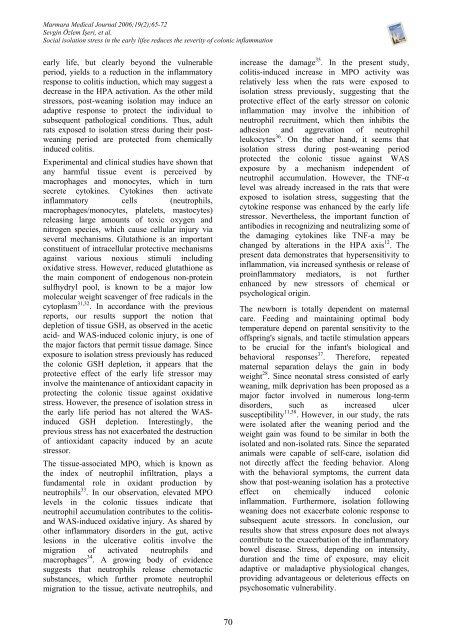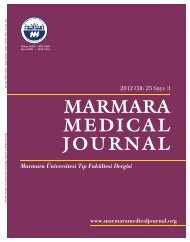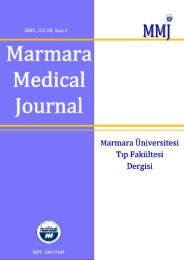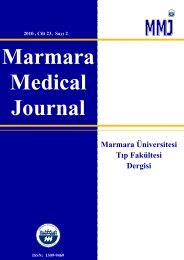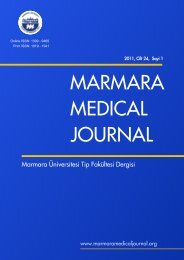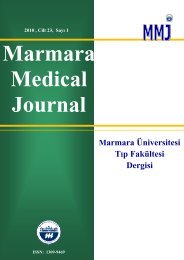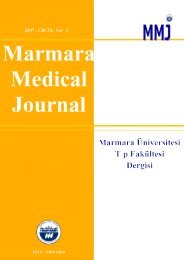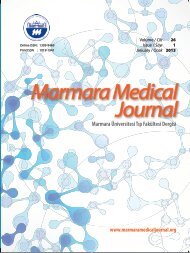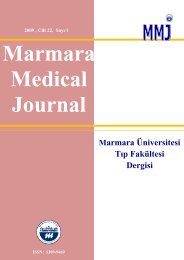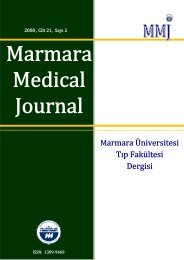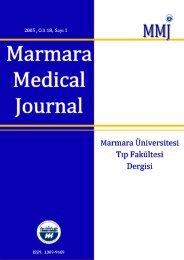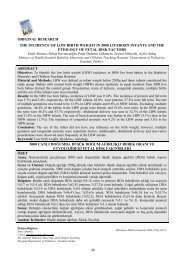Tam Metin PDF (3983 KB) - Marmara Medical Journal
Tam Metin PDF (3983 KB) - Marmara Medical Journal
Tam Metin PDF (3983 KB) - Marmara Medical Journal
Create successful ePaper yourself
Turn your PDF publications into a flip-book with our unique Google optimized e-Paper software.
<strong>Marmara</strong> <strong>Medical</strong> <strong>Journal</strong> 2006;19(2);65-72<br />
Sevgin Özlem İşeri, et al.<br />
Social isolation stress in the early lifee reduces the severity of colonic inflammation<br />
early life, but clearly beyond the vulnerable<br />
period, yields to a reduction in the inflammatory<br />
response to colitis induction, which may suggest a<br />
decrease in the HPA activation. As the other mild<br />
stressors, post-weaning isolation may induce an<br />
adaptive response to protect the individual to<br />
subsequent pathological conditions. Thus, adult<br />
rats exposed to isolation stress during their postweaning<br />
period are protected from chemically<br />
induced colitis.<br />
Experimental and clinical studies have shown that<br />
any harmful tissue event is perceived by<br />
macrophages and monocytes, which in turn<br />
secrete cytokines. Cytokines then activate<br />
inflammatory cells (neutrophils,<br />
macrophages/monocytes, platelets, mastocytes)<br />
releasing large amounts of toxic oxygen and<br />
nitrogen species, which cause cellular injury via<br />
several mechanisms. Glutathione is an important<br />
constituent of intracellular protective mechanisms<br />
against various noxious stimuli including<br />
oxidative stress. However, reduced glutathione as<br />
the main component of endogenous non-protein<br />
sulfhydryl pool, is known to be a major low<br />
molecular weight scavenger of free radicals in the<br />
cytoplasm 31,32 . In accordance with the previous<br />
reports, our results support the notion that<br />
depletion of tissue GSH, as observed in the acetic<br />
acid- and WAS-induced colonic injury, is one of<br />
the major factors that permit tissue damage. Since<br />
exposure to isolation stress previously has reduced<br />
the colonic GSH depletion, it appears that the<br />
protective effect of the early life stressor may<br />
involve the maintenance of antioxidant capacity in<br />
protecting the colonic tissue against oxidative<br />
stress. However, the presence of isolation stress in<br />
the early life period has not altered the WASinduced<br />
GSH depletion. Interestingly, the<br />
previous stress has not exacerbated the destruction<br />
of antioxidant capacity induced by an acute<br />
stressor.<br />
The tissue-associated MPO, which is known as<br />
the index of neutrophil infiltration, plays a<br />
fundamental role in oxidant production by<br />
neutrophils 33 . In our observation, elevated MPO<br />
levels in the colonic tissues indicate that<br />
neutrophil accumulation contributes to the colitisand<br />
WAS-induced oxidative injury. As shared by<br />
other inflammatory disorders in the gut, active<br />
lesions in the ulcerative colitis involve the<br />
migration of activated neutrophils and<br />
macrophages 34 . A growing body of evidence<br />
suggests that neutrophils release chemotactic<br />
substances, which further promote neutrophil<br />
migration to the tissue, activate neutrophils, and<br />
increase the damage 35 . In the present study,<br />
colitis-induced increase in MPO activity was<br />
relatively less when the rats were exposed to<br />
isolation stress previously, suggesting that the<br />
protective effect of the early stressor on colonic<br />
inflammation may involve the inhibition of<br />
neutrophil recruitment, which then inhibits the<br />
adhesion and aggrevation of neutrophil<br />
leukocytes 36 . On the other hand, it seems that<br />
isolation stress during post-weaning period<br />
protected the colonic tissue against WAS<br />
exposure by a mechanism independent of<br />
neutrophil accumulation. However, the TNF-α<br />
level was already increased in the rats that were<br />
exposed to isolation stress, suggesting that the<br />
cytokine response was enhanced by the early life<br />
stressor. Nevertheless, the important function of<br />
antibodies in recognizing and neutralizing some of<br />
the damaging cytokines like TNF-a may be<br />
changed by alterations in the HPA axis 12 . The<br />
present data demonstrates that hypersensitivity to<br />
inflammation, via increased synthesis or release of<br />
proinflammatory mediators, is not further<br />
enhanced by new stressors of chemical or<br />
psychological origin.<br />
The newborn is totally dependent on maternal<br />
care. Feeding and maintaining optimal body<br />
temperature depend on parental sensitivity to the<br />
offspring's signals, and tactile stimulation appears<br />
to be crucial for the infant's biological and<br />
behavioral responses 37 . Therefore, repeated<br />
maternal separation delays the gain in body<br />
weight 28 . Since neonatal stress consisted of early<br />
weaning, milk deprivation has been proposed as a<br />
major factor involved in numerous long-term<br />
disorders, such as increased ulcer<br />
susceptibility 11,38 . However, in our study, the rats<br />
were isolated after the weaning period and the<br />
weight gain was found to be similar in both the<br />
isolated and non-isolated rats. Since the separated<br />
animals were capable of self-care, isolation did<br />
not directly affect the feeding behavior. Along<br />
with the behavioral symptoms, the current data<br />
show that post-weaning isolation has a protective<br />
effect on chemically induced colonic<br />
inflammation. Furthermore, isolation following<br />
weaning does not exacerbate colonic response to<br />
subsequent acute stressors. In conclusion, our<br />
results show that stress exposure does not always<br />
contribute to the exacerbation of the inflammatory<br />
bowel disease. Stress, depending on intensity,<br />
duration and the time of exposure, may elicit<br />
adaptive or maladaptive physiological changes,<br />
providing advantageous or deleterious effects on<br />
psychosomatic vulnerability.<br />
70


